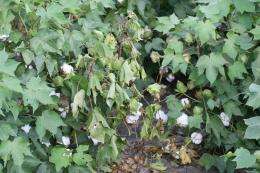Failed soybean disease leads to treatment for century-old cotton root rot disease

A dreaded soybean disease that didn’t materialize in the U.S. has led to an unintended positive impact of approximately $29 million annually for Texas cotton growers, according to officials with the Texas AgriLife Extension Service.
The disease – soybean rust, which is caused by a fungus – in recent years was thought to be an impending scourge for the Midwest. As such, a chemical capable of controlling the disease was stockpiled for use in case of such an attack.
In the meantime, cotton root rot disease, caused by a different fungus, had been stumping researchers since it was first reported in Texas in 1872. Little could be done to prevent losses in fields where this fungus appeared during the growing season, according to AgriLife Extension experts.
As the soybean rust threat grew stale, a fresh look at cotton root rot surfaced. The result is a redirected use of the soybean-approved chemical, Topguard, for cotton by special permission of the Texas Department of Agriculture. The recent decision comes after years of trials by AgriLife Extension specialists.
“I got a request from cotton growers and county Extension agents to do something about it,” said Dr. Tom Isakeit, AgriLife Extension plant pathologist in College Station. “There has been work on cotton root rot since the early 20th century, but there had been no new developments since the 1990s and no work on controls by plant pathologists.”
With funding from the Texas State Support Committee, Isakeit teamed with an AgriLife Extension integrated pest management specialist, Rick Minzenmayer of Ballinger.The two took a fresh look at the disease by a simple screening of the fungicides available on the market, because many new ones had been developed since the last studies were done on the cotton root rot.
Though the cotton disease causes an estimated $29 million in losses a year, several factors had led to its not being on the front burner for research into its prevention or treatment, Isakeit said. Its presence is small in the scheme of world cotton production, so companies that have to invest millions to develop a chemical are not likely to put research dollars into a disease that’s localized to parts of Texas and Arizona.
As a plant pathologist, Isakeit had worked more in the grain crops and knew that cotton root rot had puzzled researchers for more than a century. In fact, the disease was one of the top issues designated for scientific study when the Texas AgriLife Research agency was created in 1887, according to “Milestones,” a history of the agency formerly known as the Texas Agricultural Experiment Station.
“We started screening chemicals that not only would work against cotton root rot but that would have a good chance of being labeled (for legal use) by the companies that make them,” Isakeit said.
Because of his prior work in soybeans, Isakeit was familiar with Topguard. He also knew that it had been approved for use in the U.S. for soybeans and had been sitting on shelves unused since the soybean scare subsided.
“It was one of those serendipitous things,” Isakeit said. “Had the material been available and screened in the field, this problem with cotton root rot probably would have been solved 20 years ago. And I would have never thought to test it had not this material been labeled for use on soybean rust.”
Tests of Topguard against cotton root rot began in 2008 and the team – working in the infested field of farmers Doug and John Wilde near San Angelo – saw control with high rates, Isakeit said.
“It was really awesome,” Isakeit said of the results the first year. “You could look in the fields at the rows treated with Topguard, and they were all healthy. The adjacent rows that were not treated or treated with other fungicides had a lot of dead plants. So that was the start of it.”
But it wasn’t the end. Isakeit and his collaborators knew that the high rate of application – several hundred dollars per acre — would be too expensive for farmers.
“It wasn’t economical. We found that lower rates could be put through a drip irrigation system, but not everyone has that set up,” Isakeit said.
So the team continued to try other methods of applications and doses through 2011.
“The biggest advance was finding that we could put it out at planting, right in the seedbed as an in-furrow application,” Isakeit said. “We found activity (disease reduction) at relatively low rates of 2 pints per acre or less.”
That interested the company, Cheminova, and made it feasible for cotton farmers, he added.
Last year, in addition to the San Angelo region, the team also tested the application and rate in other parts of Texas where the disease occurs. With positive results in those areas as well, Isakeit requested via the Texas Department of Agriculture that an exemption be granted to allow the chemical to be used on cotton. That was approved by the U.S. Environmental Protection Agency on Feb. 2. It allows the use through June, which will get farmers through the planting time, Isakeit said.
Cheminova plans to continue with necessary studies to allow for Topguard to be labeled for cotton long-term, according to Steven Bradbury, director of the Texas Department of Agriculture’s pesticide programs office.
Provided by Texas A&M AgriLife


















